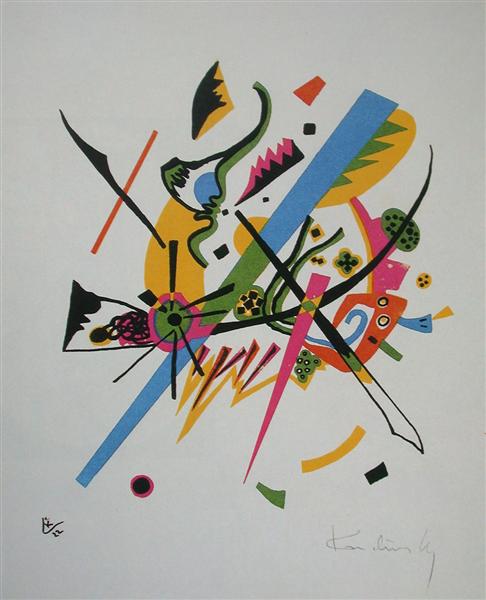Description
The work "Little Worlds" (1922) by Wassily Kandinsky is a fascinating example of the abstract style that characterizes the artist, who is considered one of the pioneers of modern art. This painting is within its most mature period, in which the exploration of the shape and color reached new dimensions. Kandinsky, in his search to express the ineffable and spiritual through painting, performs a work that meets the premise of his conviction that art should be a manifestation of the interiority of the human being.
When observing "little worlds", the viewer is immersed in a vibrant universe of geometric and organic forms that interact with each other. The composition is presented as a convulsive microcosm, a world of small entities in constant movement and transformation. The different forms, whether circles, triangles or curved lines, are organized in such a way that they seem to dialogue, suggesting a narrative that transcends the pictorial plane. This interrelation indicates the search for harmony that Kandinsky explored, where each element finds its place in the whole.
The colors in this work are of vital importance, since Kandinsky believed in the emotional force of each hue. In "small worlds", we find a rich and diverse palette that includes vibrant tones of yellow, blue and red, all combined with subtle nuances of green and orange. This bold color use not only establishes an immediate visual impact, but also evokes various emotions, from joy to melancholy. Kandinsky not only uses the color decoratively; In his work, each nuance seems to communicate intimately with the forms, one feeding the perception of the other, thus creating a sense of cohesion and dynamism.
As for the representation of characters, "little worlds" is remarkably abstract. There are no identifiable human figures, which is characteristic of Kandinsky's style. However, some could interpret the different forms as entities that represent aspects of human existence or the cosmos, urging the viewer to reflect on their own relationship with the world and the surrounding space. This absence of concrete figures allows the interpretation of the work to be open, which is one of the great wealth of abstract art.
Kandinsky, influenced by various movements such as expressionism and symbolism, struggled to go beyond the simple act of representation. In its influence on the evolution of modern art, small worlds stand as a testimony of its constant search to connect the visible and the invisible. The work also enrolls in a broader context of its production during the 1920s, where the artist continued to explore the synthesis of shapes and colors as a visual language that, beyond the limits, could resonate in the spectator.
In summary, "little worlds" of Wassily Kandinsky is not only a visual representation of an abstract world; It is a stimulus for the mind and soul, a testimony of the ability of art to evoke deep experiences and reflections. The work is configured as a microcosm where the interaction of shapes and colors allows an incessant dialogue, both between the visual elements and between the spectator and the work itself. Through this canvas, Kandinsky not only invites us to contemplate a small world, but also to discover the infinite worlds that inhabit us.
KUADROS ©, a famous paint on your wall.
Hand-made oil painting reproductions, with the quality of professional artists and the distinctive seal of KUADROS ©.
Art reproduction service with satisfaction guarantee. If you are not completely satisfied with the replica of your painting, we refund your money 100%.

